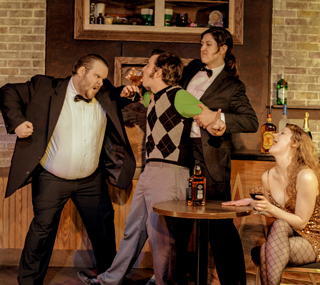
On its surface, John Godber's Bouncers is simple enough—four doormen at the Mister Cinders dance club describe a typical Saturday night on the job—in doing so, they mimic the personalities of customers, staff members, and other auxiliary personnel. They also comment irreverently on the dead-end life that drives young working-class Brits to squander money and self-esteem in the pursuit of a single evening's good time, while acknowledging their own part in perpetuating the soul-destroying cycle.
American audiences, however, saw past this depressing scenario, embracing, instead, the defiant spirit determined to seize the night before the dawn. The Next Lab's Chicago premiere in 1990 ran for nearly two years, earning five Jeff awards and forging immutable ties between its creative artists (notably, Pulitzer-winning playwright Tracy Letts, whose career-launching plays, Killer Joe and Bug, featured many of the actors sharing the stage over the long run).
This was a surprise to Chris Geiger, director of the updated adaptation currently playing at the Public House Theatre. "I wasn't aware of the play's reputation in Chicago!" Geiger confesses, "I've been fond of Bouncers ever since I was a student at the University of Alabama in 2007."
The task of forging cultural connections between the England of twenty years ago—or even longer, depending on which script you're using—with that of America today presented no problems for Geiger. "What is timeless about this play is the lure of the urban night life. We see these individuals get ready to go out, then we see them go out and get hammered, make a few mistakes and then go home—only to do it all again the next night! What makes Bouncers special is that it asks why this is an experience we all share, no matter what our generation—but it doesn't try to answer its own questions."
The earlier production was played at breakneck speed for maximum dazzle, but Geiger instructed his actors to slow down their delivery, partly to avoid sacrificing intelligibility to accuracy in pronunciation, but to savor the sly commentary of its present incarnation (featuring two acts with intermission, rap-style musical interludes and cross-gender casting). "The play is sort of a mess to read by itself," Geiger concedes, "We spent a lot of table work choosing our moments. We also went, as a group, to bars and watched them close at 4 am, in order to see what kind of people were still there."
Casting women as two of the bouncers is an innovation rarely seen in stagings of this play. "Since the play has the four bouncers playing multiple genders, I saw no reason to cast it exclusively with men—there was even a point during auditions when I considered casting exclusively with women, because we were getting so many strong, talented female performers." Geiger recalls, "What we decided we'd do is to split the specific roles across gender lines. Some of the character-based gags—like all the guys gawking at Elaine Small standing at the urinal in the men's room—are even funnier with a woman behind them."
Is it just coincidence that a story based in the quest for alcohol-fueled thrills is playing in the same theater (which comes equipped with a fully-operational bar) as the immensely popular drinking-game revue Bye, Bye, Liver? Geiger laughs, "It certainly helps, but when choosing shows we want to produce, what we look for is material that excites its artistic creators—what we call 'passion projects'—because that excitement can be sensed by audiences. Bouncers is my passion project."
Bouncers runs at The Public House Theatre through May 17.
Mary Shen Barnidge
Contributing Writer

 Follow Us On Twitter
Follow Us On Twitter